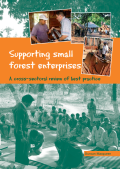Land degradation has not been comprehensively addressed at the global level or in developing countries. A suitable economic framework that could guide investments and institutional action is lacking. This study aims to overcome this deficiency and to provide a framework for a global assessment based on a consideration of the costs of action versus inaction regarding desertification, land degradation, and drought (DLDD). Most of the studies on the costs of land degradation (mainly limited to soil erosion) give cost estimates of less than 1 percent up to about 10 percent of the agricultural gross domestic product (GDP) for various countries worldwide. But the indirect costs of DLDD on the economy (national income), as well as their socioeconomic consequences (particularly poverty impacts), must be accounted for, too. Despite the numerous challenges, a global assessment of the costs of action and inaction against DLDD is possible, urgent, and necessary. This study provides a framework for such a global assessment and provides insights from some related country studies.
Healthy land ecosystems are essential to sustainable development, including food security and improved livelihoods. Yet, their key services have usually been taken for granted and their true value underrated, leading to land degradation becoming a critical global problem. This pattern of undervaluation of lands is about to change in view of the rapidly rising land prices, which is the result of increasing shortage of land and high output prices. Despite the urgent need for preventing and reversing land degradation, the problem has yet to be appropriately addressed. Policy actions for sustainable land management are lacking, and a policy framework for action is missing. Such a framework for policy action needs to be supported by evidence-based and action-oriented research. The Economics of Land Degradation (ELD) initiative seeks to develop such a science basis for policy actions to address land degradation.
In the chapter “Competitiveness, Jobs, and Green Growth: A “Glocal” Model,” Geoffrey Lipman of Greenearth.travel and Victoria University Melbourne, with Terry Delacy and Paul Whitelaw of Victoria University Melbourne, present the conceptual and operational research led by the Victoria University Centre for Tourism and Services Research to create a system where destinations can identify optimum green growth development scenarios for Travel & Tourism, to sustainably build wealth and create jobs. The authors present a conceptual global framework for green growth and travelism and show how adjusting it to the local level allowed for a major strategic visioning effort (conducted in Bali Indonesia in 2012), which has resulted in the Green Growth 2050 Roadmap.

This report reviews the growing consensus on best practice in small enterprise support, both within and outside the forest sector. It describes how a framework known as ‘market system development’ unites attempts to: strengthen enterprise associations, facilitate better provision of financial and business development services, and improve the business environment. It concludes with specific recommendations for support to SMFEs.
This paper fills a gap in the macroeconomic literature on renewable sources of energy. It offers a definition of green investment and analyzes the trends and determinants of this investment over the last decade for 35 advanced and emerging countries. We use a new multi-country historical dataset and find that green investment has become a key driver of the energy sector and that its rapid growth is now mostly driven by China. Our econometric results suggest that green investment is boosted by economic growth, a sound financial system conducive to low interest rates, and high fuel prices. We also find that some policy interventions, such as the introduction of carbon pricing schemes, or “feed-in-tariffs,” which require use of “green”energy, have a positive and significant impact on green investment. Other interventions, such as biofuel support, do not appear to be associated with higher green investment.
